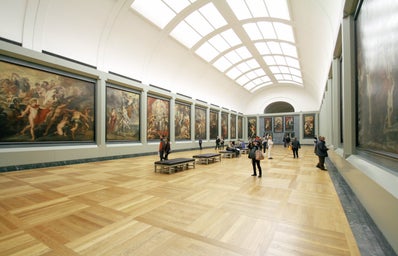From 23 May to 26 August in 2019, the Citi exhibition Manga is on at The British Museum. In the exhibition, we can see many original copies of popular manga and also learn the history of manga through some paintings and hand scrolls. The oldest comic is considered to be Choju jinbutsu giga, Scrolls of Frolicking Animals and Humans, which depicts human-like lively rabbits, frogs and monkeys (see here for details). Although we cannot see them in this exhibition since it is fragile and exhibited only a few times in Japan, The Tale of the Monkeys which is similar in depicting human-like monkeys is being exhibited.
Katsushika Hokusai
Self portrait of Katsushika Hokusai via Wikimedia Commons
In the Edo Era (1603-1868), the famous painter, Katsushika Hokusai’s (circa 1760-1849) manga became popular. He is famous for the picture of Mt. Fuji and landscapes and The Great Wave off Kanagawa as an ukiyo-e painter. His manga was like the collection of illustrations of ordinary people’s lives, fashion, animals, plants, and yokai–Japanese ghosts or monsters.
The ghost of Oiwa, Katsushika Hokusai via Wikimedia Commons
Though the common subjects of paintings at that time were landscapes and people’s lives, many artists were interested in ghosts and monsters. Hokusai painted a set of one hundred ghost pictures. However only five of them still exist (see here for details). Both Hokusai manga and ukiyo-e painting of Japanese ghosts can be seen in this exhibition.
Kawanabe Kyosai
Kawanabe Kyosai via Wikimedia Commons
Another artist who painted yokai is Kawanabe Kyosai (1831-1889). He is famous for his extraordinary painting skills learned from many schools, and the variety of things he painted.
Photo taken by the author from enpaku book, The Tsubouchi Memorial Museum
In 1880, he painted the stage curtain for the Shintomi Theatre–17m wide and 4m tall–very huge. This painting is kept in The Tsubouchi Memorial Museum at Waseda University, but it was lent to The British Museum now and can be seen in this exhibition. He was asked by his friend, playwright Kanagaki Robun, and hence painted Kabuki actors disguising themselves as yokai. It is said that he finished this painting while he was drinking rice wine, within four hours on the day he was asked. Since this curtain is too big and there is no space to exhibit at Waseda, it can be seen only in other museums or special exhibition. The last time this great painting was lent to The British Museum was twenty-five years ago and this is a rare chance to see it.
The Friendship between Kawanabe Kyosai and Josiah Conder
Josiah Conder via Wikimedia Commons
In 1881, Josiah Conder, a British architect, joined to Kawanabe Kyosai’s art school. They were good friend and he was given a name “Kyoei”, which means ‘British Kyosai’. Even when Kyosai died because of cancer, they were holding each other’s hands.
Mitsubishi Ichigokan Museum via Wikimedia Commons
Josiah Conder came to Japan in 1877 for the first time as a professor at Imperial College of Engineering (now Tokyo University). He built many famous buildings in Tokyo; Rokumeikan, built in 1883, was used as great hall to entertain guests from foreign countries and emphasized their development by western style buildings. Mitsubishi Ichigokan, built in 1894, was an office building for the Mitsubishi company and now rebuilt and used as Mitsubishi Ichigokan Museum. Also, he built greenhouse in the garden for Okuma Shigenobu, the founder of Waseda University, and many plants and fruits such as melon and bonsai (potted dwarf tree) were grown in it (see here for photos). Thus, they have a relationship with Waseda in different ways.
Also, Kyosai gave some paintings to Professor William Anderson, who was British surgeon and visited Japan due to the invitation from Japanese navy, when he left Japan. Some of them are the ukiyo-e paintings of Choju jinbutsu giga and describe cute but funny mice and cats, frogs and insects. They are also kept in The British Museum.
In The Citi exhibition of Manga, paintings by these painters can be seen. So why don’t you go to London and visit during the summer vacation?


